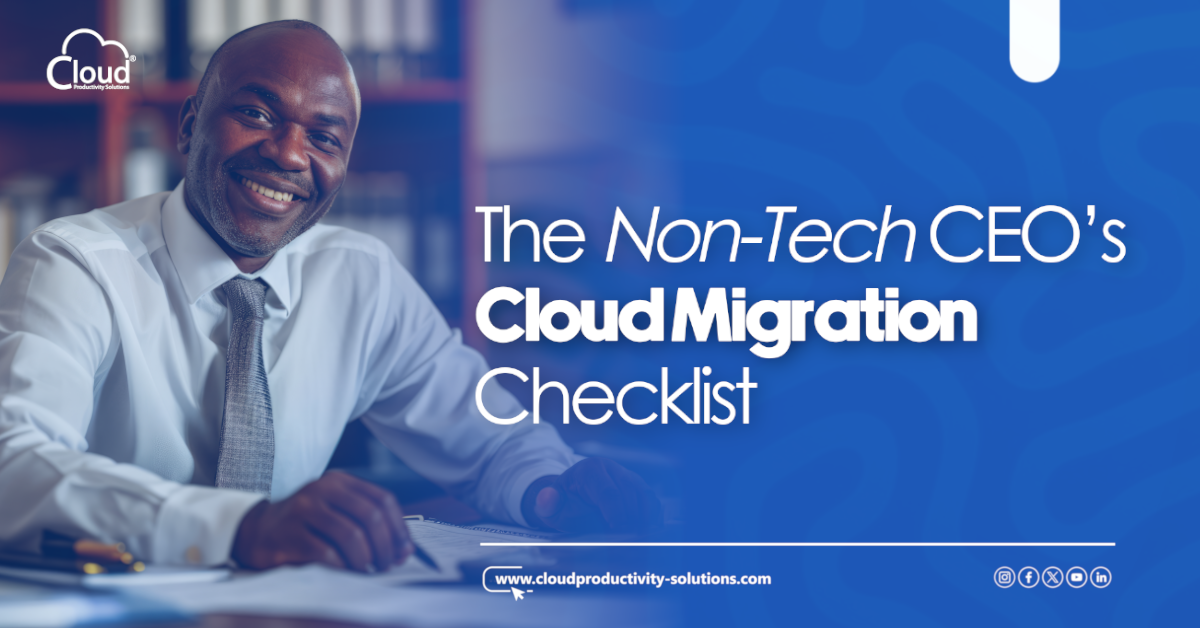
ready to get started?
Subscribe to our mailing list
Quick Links
Copyright 2025 by Cloud Productivity Solutions.

𝗜𝗺𝗮𝗴𝗶𝗻𝗲 𝘁𝗵𝗶𝘀: Your team proudly announces the cloud migration is complete, only for your entire customer portal to crash during peak sales season. Revenue plummets. Employees panic. The board demands answers.
Sound like a nightmare? It doesn’t have to be.
Cloud migration should mean flexibility, cost savings, and innovation. Yet 60% of migrations fail or blow budgets because leaders treat it as an “IT problem” rather than a business transformation.
𝗧𝗵𝗲 𝗳𝗶𝘅? A clear, step-by-step plan, no tech degree required.
Let’s be honest: If your cloud partner starts rambling about “multi-tenancy architectures” or “lift-and-shift frameworks,” your eyes glaze over. But here’s what actually matters:
• 𝗖𝗼𝘀𝘁 𝘁𝗿𝗮𝗽𝘀: Migrating the wrong apps can triple your expected spend.
• 𝗛𝗶𝗱𝗱𝗲𝗻 𝗱𝗼𝘄𝗻𝘁𝗶𝗺𝗲: That “seamless transition” promise? Often means 12+ hours of dead silence for customers.
• 𝗦𝗲𝗰𝘂𝗿𝗶𝘁𝘆 𝗯𝗹𝗶𝗻𝗱 𝘀𝗽𝗼𝘁𝘀: One misconfigured setting could expose sensitive data.
The good news? Avoiding these pitfalls isn’t about understanding code, it’s about asking the right questions upfront.
𝗣𝗵𝗮𝘀𝗲 𝟭: 𝗣𝗹𝗮𝗻 𝗟𝗶𝗸𝗲 𝗮 𝗣𝗿𝗼 (𝗕𝗲𝗳𝗼𝗿𝗲 𝗬𝗼𝘂 𝗦𝗽𝗲𝗻𝗱 𝗮 𝗗𝗼𝗹𝗹𝗮𝗿)
1.Start with the “Why” – Or Pay the Price Later
• Bad reason: “Our competitors are doing it.”
• Smart reason: “We need to scale support during holiday rushes without buying expensive servers.”
→ Action: Write down one primary goal. Tape it to your monitor.
2.Play “Keep or Kill” with Your Apps
Legacy software isn’t just old—it’s often cheaper to replace than migrate.
→ Red flag: If an app hasn’t been updated in 3+ years, pause. Audit it first.
3.Vet Vendors Like a Skeptic
Ask: “Walk me through your worst migration failure. What went wrong?”
→ Power move: Require a penalty clause in contracts for excessive downtime.
𝗣𝗵𝗮𝘀𝗲 𝟮: 𝗠𝗶𝗴𝗿𝗮𝘁𝗲 𝗪𝗶𝘁𝗵𝗼𝘂𝘁 𝗠𝗲𝗹𝘁𝗱𝗼𝘄𝗻𝘀
1)Lock Down Security Before the Move
Example: A healthcare CEO migrated patient records—only to realize after the fact that backups weren’t encrypted. $1.8M fine.
→ Checklist item: “Confirm encryption for data in transit and at rest.”
2)Test Like the World Is Watching
Pilot migrations always uncover surprises (e.g., payroll software crashes in the cloud).
→ Rule of thumb: Assume testing will take 2x longer than vendors claim.
𝗣𝗵𝗮𝘀𝗲 𝟯: 𝗣𝗼𝘀𝘁-𝗠𝗶𝗴𝗿𝗮𝘁𝗶𝗼𝗻 – 𝗗𝗼𝗻’𝘁 𝗦𝗲𝘁 𝗮𝗻𝗱 𝗙𝗼𝗿𝗴𝗲𝘁
1)Watch for Budget Creep
Cloud bills can spiral from “$10K/month” to “$45K/month” if no one monitors usage.
→ Lifesaver: Set up automated alerts for cost overruns.
2)Train Teams Before They Panic
Employees will revolt if their favorite tool suddenly looks alien.
→ Pro tip: Run “lunch and learns” where teams demo the new system before go-live.
Book a free Discovery session.Learn about
• Vendor negotiation scripts (exactly what to ask).
• A downtime calculator (realistic timeline planning).
• Red flags (terms like “data egress fees” = hidden costs).
𝗙𝗶𝗻𝗮𝗹 𝗧𝗵𝗼𝘂𝗴𝗵𝘁:
This Isn’t About Tech, It’s About Leadership
The difference between a cloud win and a cloud disaster? Clarity. When you (the CEO) set clear goals, ask tough questions, and plan for hiccups, migrations become predictable, even boring. And in tech, boring is beautiful.